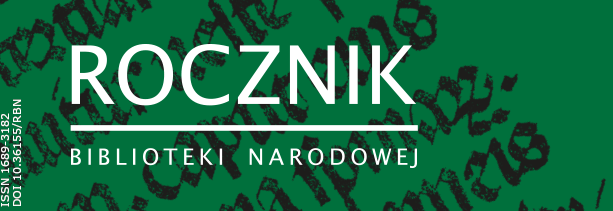NUMERY ARCHIWALNE

STRONA REDAKCYJNA, SPIS TREŚCI, s. 1–8 / CREDITS, TABLE OF CONTENTS, p. 1–8
STUDIA I MATERIAŁY / STUDIES AND MATERIALS
Semantyka słownictwa języka haseł przedmiotowych KABA w procesie adaptacji do zastosowania w systemie postkoordynowanym, s. 11–40 / Semantics of the KABA subject headings language vocabulary in the process of its adaptation to use in the post-coordinated system, p. 11–40
Semantic analysis of the lexical units of an information-retrieval language is the basic method used in the transformation of a pre-coordinated language into a post-coordinated one. In this process, the syntax of the pre-coordinated language is taken into account only in as far as it affects the modification of the meaning of a lexical unit.
The paper presents the above process on the example of adapting lexical units of the KABA subject headings language (JHP KABA) for use in the post¬-coordinated system used in modern library catalogues. JHP KABA lexical units, freed from syntactic pre-coordination, will be included in the vocabulary of the National Library of Poland Descriptors (DBN). This process requires three stages, as illustrated with examples in the text.
In the first stage, JHP KABA vocabulary is mapped with DBN vocabulary, taking into account the meaning and rules of use of each lexical unit. This is the most difficult and time-consuming stage.
The second stage consists in replacing the JHP KABA extended subject headings with a set of descriptors indicated in the first stage for individual elements of an extended subject heading. In the third stage, focusing on bibliographic records, descriptor doublets are eliminated, most often when the bibliographic description contains subject characteristics composed of several expanded subject headings. At this stage, any gaps in the bibliographic description can also be filled.
Książka zabawka w praktyce katalogowej Biblioteki Narodowej: próba definicji, typy, kwestie sporne, s. 41–60 / Toy books in the cataloguing practice in the National Library of Poland: an outline of definitions, types, and contentious issues, p. 41–60
The market of books for children and teenagers is currently an attractive one, diverse and tailored to the needs of readers. The publishers’ offer includes more and more books whose additional function is to stimulate underage readers in many ways: these are publications with windows, making sounds, of unusual shapes, that is, toy books. This article is an attempt to define toy books based on the existing literature on the subject, but also taking into account the practice of cataloguing publications for children and youth in the National Library of Poland. It describes the types and characteristics of such books as exemplified by specific publications from recent years. The cataloguing of this type of publications using the Descriptors of the National Library of Poland is also discussed.
Zastosowanie Deskryptorów Biblioteki Narodowej w katalogowaniu przedmiotowym publikacji z zakresu matematyki, s. 61–94 / Use of National Library of Poland Descriptors in subject cataloguing of publications in the field of mathematics, p. 61–94
The article presents issues related to the cataloguing of mathematical publications in connection with the profound changes that have taken place in the subject description methodology since the replacement of the Subject Headings Language by the National Library of Poland Descriptors in 2017. The text refers to both the currently applicable cataloguing regulations and the practices developed over the last few years as part of the work of the author of the article as a subject librarian in mathematics at the National Library of Poland. Particular attention is paid to the sources of information useful in creating new subject descriptors and the selection of descriptors for bibliographic descriptions of individual publications. Various examples of bibliographic descriptions and reference records can be a practical aid for librarians who catalogue mathematical publications, especially those who are not specialists in this particular field.
Klasyfikacje piśmiennictwa i ich stosowanie – wybrane przykłady, s. 95–119 / Library classifications and their application – selected examples, p. 95–119
The article discusses the classifications that are used in libraries, museums, archives, bibliographic databases and for organizing the Internet. The classifications according to their features, scope and structure are presented. The most space
was devoted to the application of classifications, both universal international, general national and specialist. Their presentation in data description and linked data model formats was discussed, as well as the issues of visualization,
mapping and interdisciplinarity.Hasło główne opisu bibliograficznego w powojennej praktyce bibliografii narodowej (książki i artykuły), s. 121–168 / The main entry of bibliographic description in the post-war practice of national bibliography (books and articles), p. 121–168
The article presents the previous practice of using the main entry in bibliographic descriptions of books registered in the Przewodnik Bibliograficzny in the years 1946–2019. All types of entries are discussed: personal name, corporate
name, meeting name and uniform title. Polish cataloguing regulations and standards concerning the formulation and use of the main entry, applicable in librarianship in the discussed period, are presented. The changes taking place in this area are shown against the background of the work undertaken by the international library community, mainly IFLA. The discussed issues are illustrated with examples of descriptions taken from the printed or electronic versions of the Przewodnik Bibliograficzny.Chrestomatie i gramatyki do nauki języka i literatury rosyjskiej w szkołach średnich Warszawskiego Okręgu Naukowego w świetle rosyjskiej polityki oświatowej w Królestwie Polskim, 1864–1915, s. 169–190 / Chrestomathies and grammar books for learning Russian language and literature in secondary schools of the Warsaw Scholar District in the light of Russian educational policy in the Kingdom of Poland, 1864–1915, p. 169–190
Both the 'great reforms' of Alexander II, as well as the outbreak and suppression of the January Uprising in Poland under Russian rule brought changes to the official state ideology of Russia. While it was still based on the triad Orthodoxy-
Autocracy-Nationality formulated by count Sergey Uvarov, the changes emphasized its last element: Natonality. From then on the latter meant not only the national tradition in the broad sense, but also Russian ethnicity, considered as
the foundation of the Russian nation. Thus, the gymnasium school textbooks (chrestomathies and grammar books) discussed in the article referred to the ethnic understanding of the nation, which was expressed by Russian fairy tales, folk poetry and proverbs on a par with the poetry of Russian Romanticism. Therefore, as in Germany or France, Russian gymnasiums also were to be a 'transmission belt' for Russian nationalism. However, some texts published in the Circular of the Warsaw Scholar District (1869–1915) show that in the Kingdom of Poland, school books had a different function than in the Russian-speaking
core of the Empire. Instead of a total cultural unification of Polish students, Russian educational authorities were striving to effectively teach the Russian language and disseminate the belief in Russian cultural domination over Polish culture.Programy teatralne (sumariusze) z Biblioteki Pisarzy (Generała) Societatis Jesu w Rzymie. Przegląd i problematyka, s. 191–261 / Theatre programmes (sumariusze) from the Library of Writers (of the Superior General) of the Societas Jesu in Rome. An overview, p. 191–261
The article presents, in the form of bibliographic descriptions, including theatrical elements, 29 theatrical programs (sumariusze) of Jesuit plays from the Library of the Superior General of Societas Jesu in Rome from the years 1694–1737. These were collected in one codex, from copies-doublets from the Vilnius University Library at the end of the 19th century. They were published by various colleges from the former Lithuanian Province of the Jesuit Order (12 colleges, mainly Warsaw and Vilnius 9 and 7 such books, respectively; Drohiczyn, Płock and Połock: 2 each; while Bobruysk, Braniewo, Minsk, Mogilev, Nowogrodek, Pułtusk and Witebsk: 1 each). The last one in the collection (no. 30) are separately published (in Warsaw, but
with the name of the Masovian Province SJ) congratulations to the newly elected Polish King, Stanislaus II Augustus Poniatowski, on the occasion of his coronation in November 1764.In addition to full bibliographic descriptions, the article introduces abundant information related to the theatre itself (sources of plays, genres, structures, characters, plots, ideas of plays, occasions of performances, etc.). In total, it provides a picture of almost half a century of activity of theatres of Jesuit schools in the Lithuanian province, especially in Warsaw and Vilnius.
Pozostałości księgozbioru kardynała Bernarda Maciejowskiego (1548–1608) w zbiorach Biblioteki Wyższego Seminarium Duchownego w Płocku, s. 263–277 / Remains of the book collection of Cardinal Bernard Maciejowski (1548–1608) in the collection of the Library of the Seminary in Płock, p. 263–277
The subject of this communication are five volumes belonging to the former collection of Cardinal Bernard Maciejowski (1548–1608), encountered by the author during a search query conducted in the Library of the Seminary in Płock. These
contain six printed publications, most of which have an apologetic and polemical purpose. Their twin-like bindings fit in with the local type of decoration, characteristic of the turn of the 16th and 17th centuries. They were probably drawn up in Wilhelm’s bookbinding workshop and each time they were provided with the supralibros of the Cardinal from the period of his service in Krakow.Księgozbiór Jana Greczewskiego według inwentarza z drugiej połowy XVII wieku, s. 279–313 / Jan Greczewski’s book collection according to an inventory from the second half of the 17th century, p. 279–313
The catalogue of books that were lost by Jan Greczewski in 1662 makes it possible to reconstruct the private library of this nobleman. He originated from a Toruń patrician family ennobled in 1580, and probably studied in Konigsberg. He then
worked as a clerk, first in crown lands, then in private estates in Podlasie, where he settled with his family. Much of his book collection has been reconstructed. It marks a person who is enlightened, curious about the world and ambitious. The analysis of his collection of books clearly shows the overwhelming influence of the German culture on the mind of the owner, and the importance of the spirituality of the Jesuits’ teaching, which probably resulted in his conversion to Catholicism.Cyfrowa rekonstrukcja kolekcji historycznych na przykładzie księgozbioru zbioru Jozefa Drege’a w zbiorach cBN Polona, s. 315–346 / Digital reconstruction of historical book collections as exemplified by Józef Drège’s collection in POLONA, p. 315–346
The dispersion of library collections, both as a result of relocations and within the libraries themselves, is a process connected with the circulation of library materials. The book collection of Józef Drege (1866–1908), unique in terms of the subject matter of the publications included in it, was dispersed. The digitization of the collections of the National Library of Poland and their presentations in POLONA digital library makes it possible to recreate the collection related with gardening.
RECENZJE I SPRAWOZDANIA / REVIEWS AND REPORTS
Daniel Brzeziński, Grażyna Szumlicka-Rychlik, Najstarsze manuskrypty (IX–XVIII w.) i inkunabuły. Zbiory specjalne Towarzystwa Naukowego Płockiego, t. 1, Płock, Towarzystwo Naukowe Płockie, 2019, s. 349–354 / Review of: Daniel Brzeziński, Grażyna Szumlicka-Rychlik, Najstarsze manuskrypty (IX–XVIII w.) i inkunabuły. Zbiory specjalne Towarzystwa Naukowego Płockiego, t. 1, Płock, Towarzystwo Naukowe Płockie, 2019, p. 349–354

